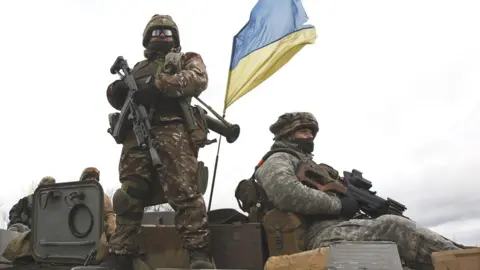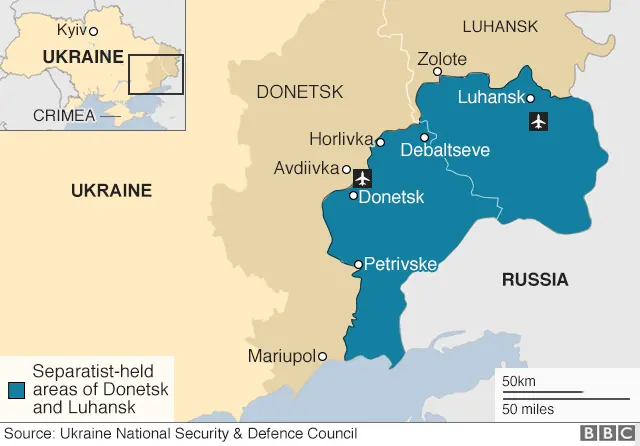Ukraine conflict: Front-line troops begin pullout
 Reuters
ReutersUkrainian government troops and Russian-backed separatists have begun withdrawing from a key front-line area in eastern Ukraine.
"The separation of forces in Zolote is happening right now," Ukrainian Foreign Minister Vadym Prystaiko said.
A separatist official quoted by Russia's RIA news agency said both sides had fired coloured signalling rockets to mark both sides' withdrawal.
A deal was agreed this month to end the Donbas region's five-year conflict.
Under the deal, both sides were to start withdrawing from their positions in the towns of Zolote and Petrivske on 9 October.
But there were skirmishes between Ukrainian police and war veterans, who tried to prevent the troop pullout.
On 26 October Ukrainian President Volodymyr Zelensky visited the scene and ordered the war veterans to disarm.

Mr Prystaiko said shooting in Zolote stopped on 17 October and the withdrawal began on Tuesday once OSCE international monitors were there to check compliance by both sides.
Ukraine's military high command confirmed that the withdrawal had begun at 12:00 local time (10:00 GMT).
 Getty Images
Getty ImagesHow did this peace deal come about?
For at least two years the fighting has been much less intense than back in 2014.
There have been daily exchanges of fire, but the front line has remained generally static.
A framework ceasefire deal was agreed in February 2015 - the Minsk agreement - but was soon violated as fighting resumed.
This year there have been several significant moves towards a peace settlement:
- President Zelensky was elected by a big majority, having set a Donbas peace deal as his number one priority
- In June, Ukrainian troops and separatists withdrew a kilometre from the front-line town of Stanytsia Luhanska
- In September, a long-awaited prisoner swap with Russia was finally completed
- On 1 October, Ukraine, Russia and the separatists agreed a deal to bring special status to the separatist-held parts of Donetsk and Luhansk regions (jointly called the Donbas)
What could be the next steps?
Mr Prystaiko said that if the Zolote disengagement goes according to plan, both sides will also withdraw from their positions in Petrivske within the next 10 days.
He also voiced hope that, next month, President Zelensky would meet Russian President Vladimir Putin for peace talks, mediated by the leaders of France and Germany, in what is known as the Normandy format.
"Several times already it was postponed for technical reasons, but you see how complicated all this is," he told reporters on Tuesday. "We are doing all we can to make this meeting happen."
The new impetus stems from a plan proposed in 2016 by Germany's then-foreign minister, Frank-Walter Steinmeier, calling for: free and fair elections in the east under Ukrainian law; verification by the OSCE international security organisation; and self-governing status for Donetsk and Luhansk in return.
What triggered the conflict?
Pro-Russian separatists seized control of large swathes of Donetsk and Luhansk regions in April 2014, just after Russia's annexation of Ukraine's Crimea peninsula.
It was an insurgency against the new pro-Western authorities in the capital Kyiv, who had ousted the pro-Russian President Viktor Yanukovych in street protests dubbed the "Maidan Revolution".
The separatists later declared independence from Ukraine - but no country has recognised their "republics".
Nato and Western intelligence experts have repeatedly accused Russia of sending heavy weapons and combat troops into eastern Ukraine to help the rebels.
Russia denies that, but admits that Russian "volunteers" are helping the rebels.
